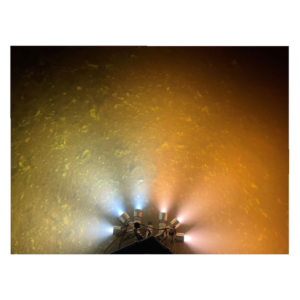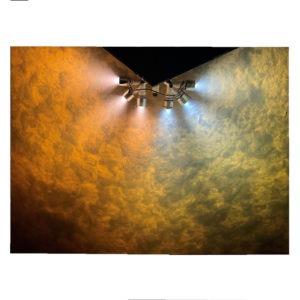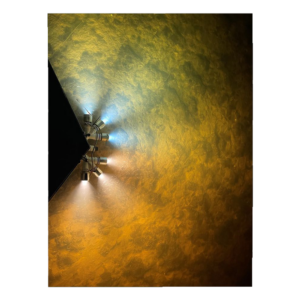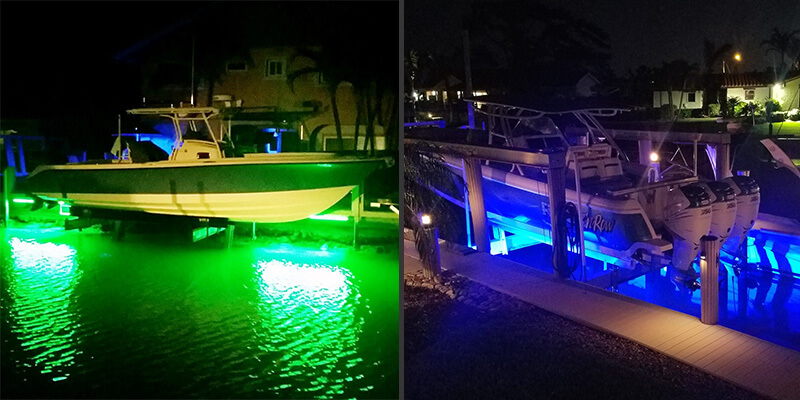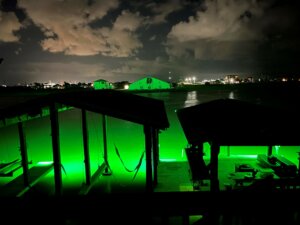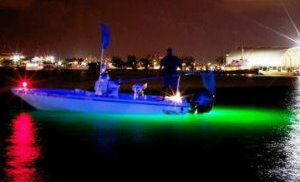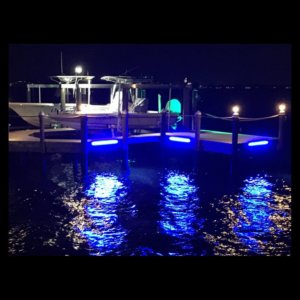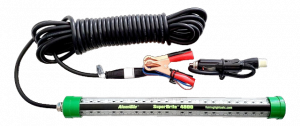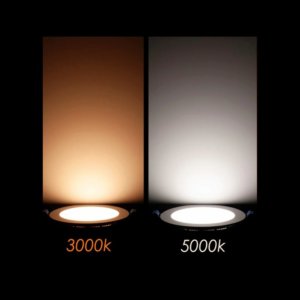While Green Light has become very popular in recent years, fisherman have caught millions of fish using White Light long before Green Light was available. The 3 primary colors of Fishing Lights and Dock Lights is Green, White and Blue and we get a lot of questions as to which color is the best color to use. ALL light will attract fish when projected on top or below the water’s surface, but there are times when one color is better than the other. If the bait fish aren’t gathering with the color you are using, you may want to think about changing to another color of light much like you would change colors of lures if the fishing was slow. Our new AlumiGlo DockPro 4500-X3 Dock Light comes with a remote control which lets you pick between Green light, White Light, or Blue light.
Which Color is the Best Color to Use?
Green Light and White Light are the most common colors used to attract fish to Boats, Docks and Piers because they are brighter and will attract fish from a greater distance. White Light is made up of all colors in the color spectrum and produces more overall lumens than any other color. If there are fish around your dock, white light will attract them to your dock faster than any other color. The downside to white light is your eyes react to it more than other colors and it attracts more bugs than other colors. Green Light is the most popular color of light we sell because it not only does a great job of attracting fish but also looks nice at night and attracts less bugs than white light. Blue Light is less bright than green but is calming and very pretty to look at. Blue light is typically used more aesthetics, showcasing boats, docks, landscaping and building fronts.
We are often asked how and why does light attract fish? The simple fact is, all light does is start a natural food chain which occurs on a daily basis when moon light, sun light or artificial light is shined onto the water. The light attracts plankton, which is a small, microscopic animal that baitfish feed on. Once the plankton arrive around the light, the baitfish and gamefish will soon follow. Read more on How Fishing Lights and Dock Lights Attract Fish
Color can be more important for fishing and shrimping. The two most popular colors used for fishing and shrimping is Green and White and while green is the most popular color for both sports, it’s always a good idea to try both colors if you are having a slow night. When testing Green Light vs White light, we found that the Green Light attracts “more” smaller baitfish while the White Light attracts less but much “larger’ baitfish in the same water. Changing colors of lights is no different than changing colors of lures when fishing different conditions.
Our new AlumiGlo SuperBrite X2 Dual Color fishing lights allow you to use Green light, White light or BOTH colors on at the same time. But, for the hard-core Green Light only fisherman we recently introduced our new SuperBrite 4800-C Green LED Fishing Light which has become a favorite for Fishing, Shrimping and Ice Fishing! The key to catching fish under the lights is attracting sufficient baitfish around the light. Once the baitfish come to the light, the larger game fish will be close behind. So, we recommend trying Green Light, White Light and a mix of BOTH colors for about 30 minutes each to see which color is going to produce the most baitfish.
Gigging – Bullynetting Lights – Picking the Correct Color Temperature
If you are purchasing our AlumiGlo FlounderPro 4400-X2 or any of the AlumiGlo FlounderPro 13000-X2 lights, you have the option of changing color temperatures and can now use either 3000K (Amber) or 5000K (Natural White).
Which color should I choose?
Color temperature is measured in Kelvin (K), and there are three common ranges of White Lights: Warm Light (2700K-3000K); Cool White (3000K-5000K), and Daylight (5500K-6500K). While most of the older incandescent bulbs and halogen bulbs were in the 3200K range and the more modern White LEDs now range between 3200K and 6500K. The higher the number is the whiter the light is until the color eventually starts to turn blue in the 7000K range.
You can find a lot of different articles and opinions on the internet pertaining to which color temperature is the best color to use for gigging and bowfishing, but typically, lower color temperatures in the 2700K to 3000K range work best in heavily stained and muddy waters and mid-range color temperatures in the 5000K range work best in moderately clear to clear water. 80% of our customers purchase 5000K lights, but if the water in your area is extremely stained or muddy, you may want to consider using a lower color temperature.
Why lower color temperatures work better in dirty water.
Lower color temperatures work better in stained, dirty, and muddy waters because the yellowish tint produced by the lights do not reflect off of the mud particles in the water as badly as the whiter, high color temperatures do therefore producing less glare in the water. Higher color temperatures appear to be much whiter and brighter when compared side by side to lower temperature colors, but they also produce more glare in stained water. The easiest way to explain why lower color temperatures work better in dirty water is to compare the stained water to shining your bright lights in fog. Turn bright lights on in the fog and they shine right back in your face. However, the lower color temperature (more yellow) fog lights do a better job of cutting through the fog with less reflection.
If you primarily fish in heavily stained or dirty waters, a lower color temperature in the 2700K to 3000K (Amber) range may work best for you. Just remember, the lights will look much yellower and will not look as bright when compared to the higher color temperature lights, but they should provide better overall visibility because there will be less glare from reflection. If you are fishing in moderately stained to clear water, color temperatures in the 5000K to 6000K range would be your best option.
We want to thank Alan Hults for taking and sending us some great pictures of a flounder gigging rig he made using (6) FlounderPro (30W) COB lights. He, like many of our other customers was curious which color temperature would work best for him…3000K or 5000K. The attached pictures show (3) 3000K lights and (3) 5000K lights side by side, which may help you decide which color would work best for you. The water Alan was fishing in was moderately clear and he said he preferred the 5000K color to the 3000K, however, we do have some customers who fish in much dirtier water who prefer the lower color temperature. With that said, the majority of lights we sell are 5000K and do work the best in most waters, but with these pictures you can decide for yourself.
